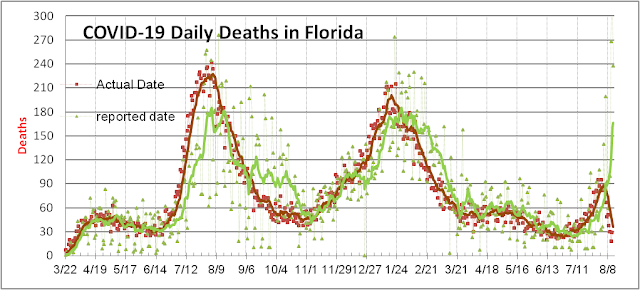Schools are New Hot Spots for COVID-19
Many students have been back to school for a month now and we are seeing new outbreaks of COVID-19 cases among young people in Florida and throughout the USA. Fortunately, the June to August resurgence of COVID-19 cases among the general population has eased so that the overall case counts in Florida have not increased yet. As we had pointed out before COVID-19 is far less deadly for children and young adults but their rates of infection may not be all that different. From the graph below, children younger than 15 seem to be less likely to get infected but since many have been staying home until recently, and as a group they were thought to be less vulnerable and tend to be under-tested, Thus it is not clear yet what their true infection rate is. The age group with the highest infection rate is young adults 25-34 who have been most socially active and were largely responsible for the summer surge in deaths as they went to bars and beaches and transmitted the disease to older adults.
The summer age transfer can be seen in the graph below. The median age of new cases in Florida decreased from 44 years old in the spring to 33 in late June, and increased back to near 44 in August as the disease spread throughout the state. Recently as schools reopened and students became more mobile, the median age in Florida has dipped to near 36 years old.
Schools at all levels of K-12 grades have encountered increased infections as they opened classrooms and campuses to children. Young kids can get the disease and transmit it but below the age of 14, they seem to be only half as infectious as the general population (infections could be undercounted due to under testing). Within K-12 ages middle school kids seem more susceptible than elementary school kids but the statistical significance is not very high. High school kids 14-17 years old appear to be 70% more likely to get COVID-19 than elementary school kids, 5-10 years old. More detailed data by school district would help us understand the underlying school reopening issues better.
Young adults aged 15-24 have been tracking higher than the general population all summer even with schools closed, but as colleges reopened in Florida in late August, the infection rate for this age group suddenly increased more than the general population. This population segment contributes 27% of all new cases in Florida even though it has only 12% of the population. The pandemic in the USA could be reignited as colleges are pushed to resume in-person classes and large scale contact activities such as football. Some colleges are well prepared in terms of testing, contact tracing, and selective isolation but many others are not. If and when they are overwhelmed and send students home or off campus for remote learning, the risk of community transmission could rise. The median age of new cases after dipping in September could rise again in October as students infect older adults in Florida and the rest of the USA.
Until the community where the school is located has its outbreaks under control, schools, especially colleges, should reopen remotely. If colleges chose to reopen for in-person classes, they must exercise extreme care and follow guidelines recommended by this unreleased CDC document. Unless they do so, reopening can blow up and put the local community and the country at risk.






Comments
Post a Comment